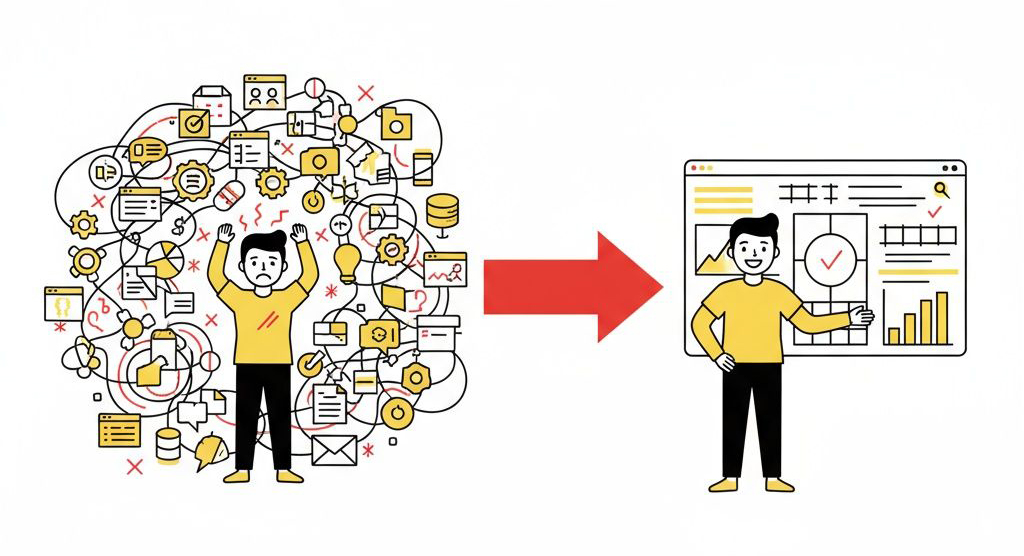When people ask about RigER’s biggest competitor, they usually expect to hear the name of another software vendor.
But over the years, I’ve realized something very different:
Our biggest competitor isn’t another company.
It’s our own resistance to adopting better tools.
This insight didn’t come from market research. It came from looking honestly at how we were running our own business.
How We Ended Up with 15 Different Tools
In the early days of RigER, as our client base and team grew, we did what most companies do:
We added more tools.
- A system for product development tasks
- Another for customization projects
- A separate platform for support tickets
- Spreadsheets for invoicing and time tracking
- Tools for client implementation projects, incident reporting, product roadmaps, accounting, CRM, sales quotes, and more
One day I stopped and counted:
we were using 15 different software solutions – some manually connected, others loosely integrated, many not integrated at all.
On paper, it looked like we had “systems” for everything.
In reality, we had created a fragmented, complex operational environment.
The Hidden Cost of Disconnected Systems
Managing this patchwork of tools consumed a tremendous amount of time and energy:
- Data lived in silos – each department had its own version of the truth.
- Team members worked with different information – what sales saw didn’t always match what implementation or support saw.
- Priorities became unclear – projects, tickets, and tasks were tracked in different places, making it hard to see what truly mattered across the company.
We weren’t just managing our business – we were managing our tools.
That’s when it became clear: the problem wasn’t a lack of software.
The problem was a lack of integration and alignment.
The Turning Point: Building Our Own Operational System
After that realization, we made a strategic decision:
We would build our own internal operational system – based on RigER │ Oilfield Job Management Software.
And yes, that means exactly what it sounds like:
We run RigER on RigER.
We chose to use our own platform to manage:
- Product development and roadmaps
- Customization projects
- Client implementation and onboarding
- Support tickets and incident reporting
- Time tracking and resource allocation
- Sales, quotes, and account management
This wasn’t just a technical decision. It reflected a core principle of our software development philosophy:
Use it or lose it.
If we don’t rely on our own solution every day, how can we expect our clients to trust it with their operations?
“Use It or Lose It”: Why We Run on RigER
Building our internal operations manager on top of RigER took time.
It wasn’t a weekend project. It took several years to:
- Map our real processes into the system
- Refine workflows based on daily usage
- Add features we discovered we needed only after living in the software
- Continuously improve as our business evolved
We still add new capabilities based on real-world usage and changing requirements.
That feedback loop – between our own operations and our product roadmap – is now one of our biggest strengths.
One Source of Truth for the Entire Company
Today, instead of 15 disconnected tools, we have:
- One source of truth for all operational data
- One place to see project statuses, priorities, and workloads
- One system that connects sales, implementation, support, product, and finance
The impact has been significant:
- Everyone understands current priorities.
- Project statuses are visible across departments.
- Resource allocation is clear and data-driven.
- The entire team stays synchronized, regardless of function or location.
We eliminated the complexity of managing multiple disconnected tools—and in the process, we improved both our operational efficiency and our decision-making.
Overcoming Resistance with Integrated Solutions
Using RigER │ Oilfield Job Management Software, companies can:
- Consolidate scattered tools into a single integrated platform
- Align operations, accounting, and management around one source of truth
- Reduce manual work, duplicated data, and conflicting information
- Gain real-time visibility into jobs, equipment, and financial performance
Our own journey—from 15 tools to one integrated system—reinforces why we built RigER the way we did:
To help service companies overcome internal resistance, simplify their operations, and achieve true operational excellence.
